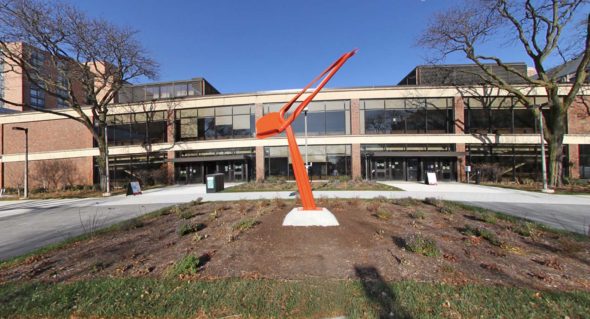‘All are related’

By Elise Archias
Ted Sitting Crow Garner is a member of the Standing Rock Sioux tribe and studied in UIC’s Native American Studies program in 1973. He has also participated in Chicago’s rich history of public sculpture since 1974 when he first learned how to install massive steel structures for other artists before going on to build his own. In July 2020, Garner’s expertise and heritage came together dramatically when he was asked to be part of the team to take down the statue of Christopher Columbus in Grant Park after activists’ unsuccessful (and potentially unsafe) attempt led Mayor Lori Lightfoot to decide it was time to remove it. Garner believes in public safety not the destruction of art, but he registered his feelings about the injustices inflicted upon indigenous peoples in the Americas since 1492 with a banner of tape on the base that remained in Grant Park. It read: “REMOVED BY MEMBER OF STANDING ROCK SIOUX TRIBE. [Peace symbol] MITAK OYASIN!” with the last phrase after the peace sign meaning “All Are Related” in the Lakota language.
In light of 2020’s intense public debate about which works of art can and cannot stand for the American population’s collective desires, it is fitting that Garner’s Tussle (2009) was installed in December in a public square on the University of Illinois Chicago’s west campus on South Wolcott Avenue near Polk in front of the student center, a block away from UI Hospital. Tussle is a big, bright, red-orange abstraction of welded steel. With its long tubes extending to meet in an imperfect point, Tussle looks a little like the head of a bird. More precisely, it looks like the great wooden masks of birds carved by North West Coast artists that Garner was surrounded by as a child (as American Indian/Caucasian anthropologists, his parents specialized in indigenous art and culture). But Tussle also speaks the language of modernist abstraction, which is to say, it shuns clichés and familiar narratives in favor of a stranger language of qualities and dynamics that take time to get on terms with. The qualities included in Tussle’s set of relationships include both the solidity of a skyscraper’s infrastructural girders and the hollowness of animal bones; the straightness and tension of lines extending in opposing diagonals; the precariousness and grace of a column leaning deeply backward, only to be counterbalanced by beak-arms reaching toward the sky like a dancer. Because Tussle is asymmetrically arranged over its narrow footing, twisting around an unmarked plumb line, viewers cannot easily figure out how it stays so balanced (the bolts at the base don’t seem nearly strong enough), but we trust that it is stable, appreciating the countless decisions that have gone into making the sculpture’s many different parts hang together as a whole.
A birdlike form from the deep past made of steel for the modern city, then, abstracted in the visual language of the twentieth century to acknowledge that there is no going back in time; but also to assert that the ideas, values, and aesthetics of indigenous cultures are here, informing the contemporary world. Why not integrate these ideas more consciously into what we build? Garner’s work is nothing if not integrationist — joining the many visual, technical, and historical ways of knowing that constitute his understanding of the world, his view, his mind. He unites them not for the sake of erasing difference, but of harmonizing it. There is no purity, this work says. But there is a city. A public university with open spaces. An audience of strangers who will pass by on their way to class, medical appointments, and hospital visits. Tussle will become a familiar presence to them. I’m here for you, the sculpture says. I’m of your time, made of the materials of your city, but I’m not going to let you have me easily. You are going to have to look at my sharp, edgy, twisted components for a while before you will be able to get what I have to say. But once you do, we will share an understanding. Because you know as well as I do how it is to be solid and empty, barely grounded because you’re reaching so high, trying to grab precisely, but ending up with a grip just slightly askance, then deciding in the end, this is the hold on the world you wanted all along.
– Elise Archias, associate professor of art history and chair of UIC’s Fine Arts Review Committee
Categories
